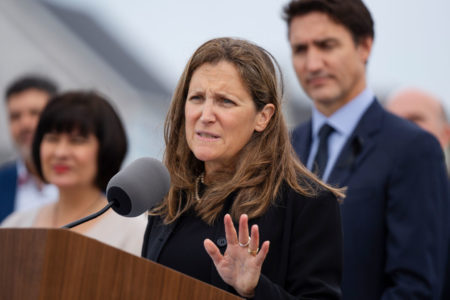
July 1, 2020 is the 10-year anniversary of Ontario’s Harmonized Sales Tax (HST), a key part of Ontario’s comprehensive tax reform package. The package included major changes to the province’s corporate and personal income taxes designed to enhance Ontario’s tax competitiveness and the progressivity of its tax system. A decade ago, replacing the 50-year-old Retail Sales Tax with a value-added tax was one of the biggest tax reform initiatives in Ontario’s history. It removed billions of dollars in hidden sales tax on business inputs including exports and, to level the playing field, substantially expanded the tax base to include a vast array of exempt services.
This base expansion generated considerable opposition as consumers were now subject to an 8 percent tax on a lot more of their purchases (the GST already applied). It was an all-of-government effort to implement, and involved strong collaboration with the federal government, the private sector, think tanks, and Indigenous partners.
Despite overwhelming opposition to the idea and the fact that it was considered to be political suicide, Ontario relentlessly pushed forward with the HST in response to the financial crisis of 2008. At the time, the International Monetary Fund concluded that 2008 experienced the most severe economic and financial meltdown since the Great Depression. The big auto companies in the US and Canada were on the verge of collapse. Canada was seeing a sizable deterioration of its economic performance and fiscal position. While this period does not even closely compare to the economic and fiscal situation we face today, the question remains – are the lessons learned 10 years ago relevant today?
In 2008, Dalton McGuinty, who was then Ontario premier, already needed to do something bold to improve Ontario’s competitiveness. Don Drummond and Derek Burleton of the TD Bank had written a seminal analysis calling for a provincial strategy to boost Ontario’s lagging productivity and competitiveness. Faced with even greater economic threats as a result of the recession, the premier asked this critical and timely question: if you could do one thing to boost competitiveness, what would you do? He got the same answer time after time – tax reform including corporate tax cuts and sales tax harmonization; and that is what he directed provincial officials to make happen.
The reform of Ontario’s tax system was introduced in the 2009 budget, aptly titled Confronting the Challenge, Building our Economic Future. It was a comprehensive tax plan implemented over an ambitious 15-month timeline. Ontario would move to a Harmonized Sales Tax, based on the federal GST value-added tax, to boost investment and productivity. (As it now stands, almost three decades after the introduction of the Goods and Services Tax (GST), all provinces from Ontario east have a value-added tax in place.)
To help through the adjustment period, and to provide ongoing tax cuts, the province provided $10.6 billion in tax relief for people over three years, which included a broad-based permanent income tax cut, enhanced low income tax credits, and direct payments through the Sales Tax Transition Benefit. The government also introduced $4.5 billion in business tax relief over three years, including specific measures to help grow and scale-up small businesses. The tax plan resulted in significant revenue loss for the federal and Ontario governments in order to boost the economy when it needed it most. It helped to pave the way for long-term economic growth.
The tax reform package dramatically cut in half Ontario’s marginal effective tax rate on new business investment, improving Ontario’s competitive position relative to other jurisdictions. It was viewed then as the single most significant action the government could take to strengthen the Ontario economy for the long term.
There is no denying that the financial and economic challenges a decade ago are modest compared to what the provinces, territories, municipalities, and the national government are facing today. It is hard to imagine any part of the economy that is not dramatically impacted. The pandemic has also revealed significant social and economic vulnerabilities, such as our fragile long-term care system, weak supply chains, and the disregard of those providing essential services. The combination of the pandemic and the abrupt fall in energy prices is having dramatic effects right across Canada.
On the other hand, governments and the private sector have shown great ingenuity in responding to the pandemic, such as by providing expanded public health services, temporary emergency relief, personal protective equipment, web-based tools to support business continuity, and logistics, distribution and delivery of essential services. Perhaps for some, the pandemic was the imperative to make changes long overdue.
What are the lessons from the post-2008 financial crisis that can be applied today? Three key observations are worthy of note drawn from the experience a decade ago when implementing the HST.
First, we are obligated to successive generations to leave them better placed to tackle the stunning list of challenges that they will face including climate change, income inequality, and growing government debt. Dramatically improving Canada’s competitiveness was the mindset in 2009, when Ontario made the difficult political decision to proceed with the HST notwithstanding tremendous opposition.
The long-avoided decision to move to the HST was a bold move a decade ago. What will be today’s bold moves to set the country on a path to recovery and address both the glaring gaps and the opportunities the pandemic has revealed? Besides strengthening public health and our long-term care system, government will need to address the pervasive nature of precarious employment, the persistent issue of regulatory burdens that can undermine productivity and the achievement of better outcomes, and the digital divide leaving large segments of society behind.
The second lesson is that large unforeseen events, such as today’s COVID pandemic and the 2008 financial crisis, are inevitable. However, there is no guarantee that all key actors will work together to find a path forward so that we come out of this situation better then when we went into it. The key is to continue to put aside inflexible partisanship and intergovernmental positioning in order to deal with the emergency and to develop an action plan that will better serve society now and in the future.
Like the tax reform in 2009, we will need strong conviction, durable partnerships, and rigorous analysis in order to make the right decisions to rebuild our economy. We need the federal government, provinces, municipalities and key stakeholders coming together to chart new fiscal arrangements for the future that will strengthen and enhance the effectiveness of our federation.
Third, history has shown that in the aftermath of a critical event, how society responds to the event can shape our future prosperity. Those that create more inclusive institutions that foster greater equity, entrepreneurship and innovation can produce better outcomes and greater social cohesion.
Like the recovery plan after the 2008 financial crisis, Canada will need a comprehensive approach to building a more productive and competitive economy – one that will capture new global markets, outpace burgeoning government debt and generate a more inclusive and sustainable society. To start, Canada will need a comprehensive, all-of-society approach to building a more innovative ecosystem – from knowledge workers to idea generation to commercialization to capturing more of the benefits in Canada. Given the size of the current challenge, we will need to redouble our efforts to ensure that we come out of this situation stronger and more resilient.
This article is part of the The Coronavirus Pandemic: Canada’s Response special feature.












